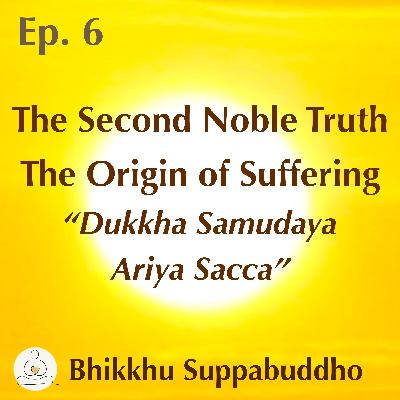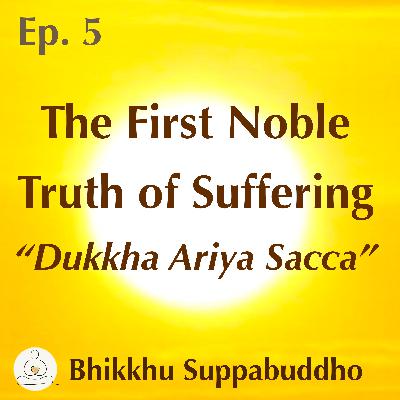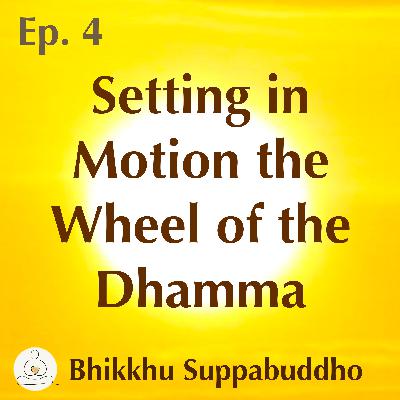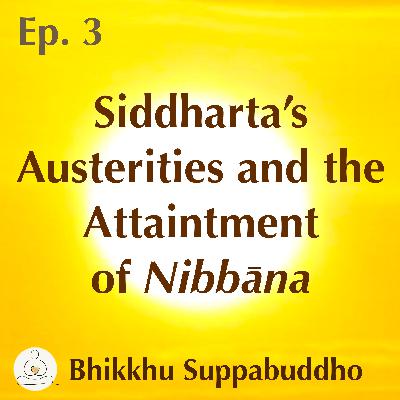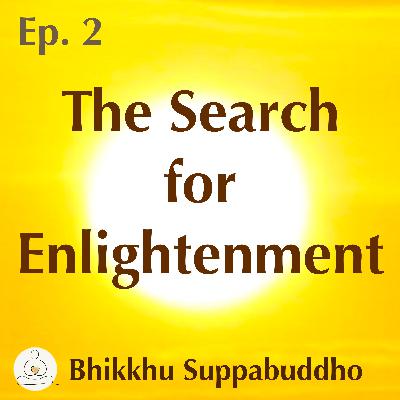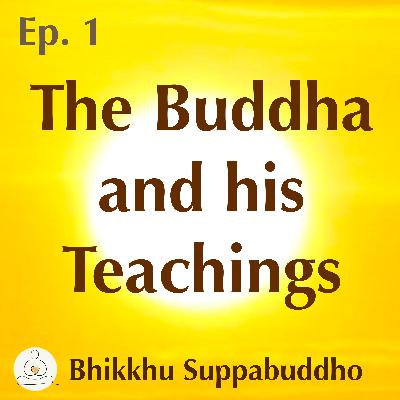Discover Heart Dhamma
Heart Dhamma

Heart Dhamma
Author: Bhikkhu Suppabuddho
Subscribed: 0Played: 1Subscribe
Share
© Bhikkhu Suppabuddho
Description
Turn your attention inwards and gain reflective insight into the nature of reality. Develop and cultivate the qualities of virtue, concentration, and wisdom, which give rise to clarity and equanimity when facing the challenges of modern life.
Join Bhikkhu Suppabuddho in these sessions to learn and practice the teachings of the Buddha that lead to inner peace and harmony of the heart.
Join Bhikkhu Suppabuddho in these sessions to learn and practice the teachings of the Buddha that lead to inner peace and harmony of the heart.
6 Episodes
Reverse
The second noble truth, “Dukkha Samudaya Ariya Sacca,” explores the origin of suffering, emphasizing the human tendency to seek pleasure and avoid pain. The Buddha encourages us to recognize the gratification, danger, and escape from the world, urging us to see things as they truly are. By understanding the nature of our existence and our relationship with the world, we can break free from the cycle of suffering and achieve true happiness.The Buddha teaches that true happiness cannot be found in the conditioned realm of birth and death, as all conditioned things are transient and subject to change. To attain genuine happiness, one must detach from conditioned aspects and seek freedom from suffering. The root cause of suffering, according to the Buddha, is craving (taṇhā), which leads to the cycle of rebirths and perpetuates dukkha.Craving, or “taṇhā,” is the root cause of suffering, leading to unwholesome qualities and outcomes. There are three forms of craving: sensual craving, craving for existence, and craving for non-existence. Craving perpetuates the cycle of rebirth, causing dissatisfaction and suffering, and must be abandoned to end this cycle.Reference from Suttas: Bhikkhu Bodhi, The Numerical Discourses of the Buddha (Wisdom Publications, 2012). "Before Enlightenment," "Gratification I," and "Gratification II."(00:00:00) Welcome(00:00:28) Are the Buddha and his Teachings Pessimistic?(00:03:35) Dhamma Flows Against Worldly Norms and Conventions(00:04:54) The Gratification, Danger and Escape from the World(00:10:07) Knowing and Seeing Things as they Really Are - Yathā-Bhūta-Ñāṇa-Dassana(00:11:11) Enjoyment, Gratification and Satisfaction - Assāda(00:12:24) Danger and Unsatisfactoriness - Ādīnava(00:13:06) Release or Escape - Nissarana(00:13:42) Reflection on the Gratification, Danger and Escape from the World(00:25:08) The Importance of Rebirth in Fully Understanding Dukkha(00:26:07) Saṃsāra - The Perpetual Wandering in the Wheel of Rebirths(00:29:32) Root Causes vs. Symptoms(00:32:59) Dukkha Samudaya Ariya Sacca - The Noble Truth of the Origin of Suffering(00:34:07) Taṇhā, Craving vs. Desire(00:36:31) Kāma-Taṇhā - Craving for Sensual Pleasures(00:37:51) Bhava-Taṇhā - Craving for Existence(00:38:21) Vibhava-Taṇhā - Craving for Annihilation or Non-Existence(00:38:51) Craving as the Underlying Cause of Dukkha(00:41:26) The Suffering of Lack(00:42:13) The Suffering of Protection(00:43:46) Taṇhā as The Driving Force for Saṃsāra(00:46:17) Taṇhā as The House Builder(00:47:20) Closing(00:47:46) Homage to The Triple Gem: Buddha, Dhamma and Sangha
The Dhamma, the Buddha’s teachings, should be approached with the right intention as a path to enlightenment, not as a creed or intellectual exercise. It serves as a guide, like road signs, leading from ignorance to wisdom. The Dhamma, arising from the Buddha’s awakening, encapsulates the truth inherent in our experiences and requires a journey of self-discovery.The Four Noble Truths, the foundation of the Dhamma, revolve around the concept of dukkha, or suffering. Dukkha encompasses not only physical pain but also the unsatisfactoriness inherent in all existence due to impermanence and craving. The Buddha outlined three distinct types of Dukkha: occasional dukkha (birth, aging, sickness, death), frequent dukkha (union with the unpleasant, separation from the pleasant, and not getting what one wants), and constant dukkha (implying that all experiences of the mind-body phenomenon - the five aggregates subject to clinging - are inherently suffering due to their impermanence, constant change and lack of an inner core or substance). The Four Noble Truths provide a roadmap to transcend suffering and attain enlightenment.(00:00:00) Welcome(00:00:39) Approaching Dhamma The Right Way(00:02:47) The Essence of Dhamma(00:04:58) The Elephant Footprint(00:06:01) The Four Noble Truths - "Cattāri Ariya Saccāni"(00:08:02) The Profound Meaning of Dukkha(00:09:55) Sacca: An Existing Reality(00:11:23) Ariya - Noble(00:12:53) The First Noble Truth of Suffering “Dukkha Ariya Sacca"(00:13:47) The Different Forms of Dukkha(00:18:52) Reflection: The Direct Experience of Dukkha(00:26:01) The Five Aggregates Subject to Clinging “Pañcupādānakkhandha”(00:29:10) Material Form “Rūpa”(00:29:53) Feeling “Vedanā”(00:30:22) Perception “Saññā”(00:30:37) Mental Formation “Sankhārā”(00:30:59) Consciousness “Viññāṇa”(00:32:16) Three Distinct Types of Dukkha(00:32:33) Dukkha Due to Pain “Dukkha Dukkhatā”(00:33:19) Dukkha Due to Change “Vipariṇāma Dukkhatā”(00:35:37) Dukkha Due to Formations “Saṅkhāra Dukkhatā(00:36:41) Closing(00:38:01) Homage to The Triple Gem: Buddha, Dhamma and Sangha
Siddhartha, after leaving his ascetic friends, sat beneath the Bodhi tree and vowed to attain enlightenment. He faced a battle against Māra, the embodiment of desire and attachment, who tried to tempt, frighten, and seduce him. Ultimately, Siddhartha defeated Māra, entered profound states of meditation, and gained the three knowledges leading to his awakening.The Buddha, after attaining enlightenment, surveys the world and finds beings at different levels of development. He decides to teach the Dhamma, starting with his former teachers, but they have passed away. Instead, he journeys to the Deer Park in Isipatana to teach his five ascetic friends, who initially doubt him but eventually listen to his first discourse, the Dhammacakkappavattana Sutta, outlining the Middle Way, thus setting in motion the wheel of Dhamma bringing the Buddha's teachings to the world.Reference:Bhikkhu Bodhi, The Connected Discourses of the Buddha (Wisdom Publications, 2000)Bhikkhu Ñāṇamoli & Bhikkhu Bodhi, The Middle Length Discourses of the Buddha (Wisdom Publications, 1995)(00:00:00) Welcome(00:00:30) Beneath the Bodhi Tree(00:01:28) The Battle with Māra(00:05:55) Enlightenment(00:08:17) Brahmā Sahampati's Plead(00:13:56) Teaching the Dhamma(00:15:34) Upaka(00:17:39) Meeting the Five Ascetics(00:20:56) Setting in Motion the Wheel of Dhamma(00:36:25) Homage to The Triple Gem: Buddha, Dhamma and Sangha
Siddhartha, in his pursuit of enlightenment, subjected himself to extreme ascetic practices, including extreme fasting, self-mortification, and seclusion. Despite his unwavering dedication and the immense suffering he endured, he realized these practices did not lead to enlightenment. This insight prompted him to question the effectiveness of his path and consider alternative approaches. Siddhartha, after abandoning his austere practices, regained strength and focused on meditation, entering the four jhānas. Through this deep concentration, he attained three crucial knowledges: recollection of past lives, the cycle of birth and death based on actions, and the destruction of taints. His enlightenment led him to discover the Four Noble Truths and become a perfectly enlightened Buddha.(00:00:00) Welcome(00:01:11) Siddhartha's Austere Practices(00:06:30) Reflection(00:10:35) Abandoning the Practices of Asceticism(00:14:14) The Path to Enlightenment, Nibbāna(00:18:38) Attaining Nibbāna(00:25:50) Sammā-Sambuddha(00:26:38) Reflection(00:30:14) Homage to the Triple Gem: Buddha, Dhamma and Sangha
The Buddha distinguishes between the noble and ignoble search, with the noble search seeking liberation from suffering and the ignoble search perpetuating it. The Buddha reflects on his own journey, realizing the futility of seeking what is subject to birth, aging, sickness, death, sorrow, and defilement. This realization leads him to abandon his privileged life and embark on a quest for enlightenment, ultimately finding the path to Nibbāna.Siddhartha, seeking enlightenment, studied with two teachers, mastering their teachings but finding them unsatisfactory as they did not lead to the cessation of suffering. Rejecting the offers of succession, he continued his search, eventually abandoning extreme asceticism and finding enlightenment through practice, introspection, and insight into the nature of suffering. His journey illustrates the importance of intention and self-reflection in overcoming suffering and achieving enlightenment.Reference:Bhikkhu Ñāṇamoli & Bhikkhu Bodhi, The Middle Length Discourses of the Buddha (Wisdom Publications, 1995). "The Noble Search."(00:00:00) Welcome(00:00:49) The Buddha's Discourse on the Noble Search(00:01:47) The Ignoble Search(00:06:09) The Noble Search(00:07:35) The Importance of Intention in our Quest(00:10:21) Discovering Suffering and the Intention to find its Solution(00:15:22) Āḷāra Kālāma(00:20:05) Uddaka Rāmaputta(00:23:26) The Five Ascetics(00:28:03) The Nature of Suffering Defines the Path to Follow(00:30:32) Relating with Siddhartha's Life and Story for our Benefit(00:34:19) Homage to the Triple Gem: Buddha, Dhamma and Sangha
The Buddha, the enlightened one, rediscovered the path to liberation from the cycle of birth and rebirth and made it known to the world. The Buddha’s teachings, or Dhamma, are the universal truth and laws governing all living beings. The Buddha’s life, from his privileged upbringing as Prince Siddhartha to his enlightenment, serves as a reminder that spiritual awakening is accessible to all.Siddhartha, the future Buddha, experienced four pivotal encounters with old age, sickness, death, and a renunciant monk. These encounters sparked deep reflections on the nature of existence and suffering, leading him to question his privileged life as a prince. Ultimately, Siddhartha renounced his royal life, seeking enlightenment and the path to liberation from suffering.The Four Noble Truths, as expounded by the Buddha, outline the nature of suffering, its cause (craving), the possibility of its cessation (Nibbāna), and the path to achieve it through the Eightfold Noble Path. By understanding and aligning with these truths, individuals can awaken to the Dhamma and find a way to alleviate suffering. This awakening involves recognizing and addressing one’s own suffering, cultivating intention, and developing qualities like faith, trust, mindfulness, and concentration.(00:00:00) Welcome(00:00:21) What is Dhamma?(00:03:36) What does "Buddha" Mean?(00:04:37) The Function of The Buddha and his Qualities(00:08:25) Siddhartha Gautama(00:11:57) The First Encounter - Old Age(00:13:25) The Second Encounter - Sickness(00:14:50) The Third Encounter - Death(00:16:39) The Fourth Encounter - A Renunciant(00:22:42) Siddhartha Faces his Father, King Suddhodana(00:27:07) Siddhartha Abandons the Palace(00:27:48) Reflection(00:30:18) Rediscovering the Dhamma(00:33:43) The Buddha's Gift to the World - The Four Noble Truths(00:34:26) The First Noble Truth - Suffering(00:36:40) The Second Noble Truth - Craving(00:38:07) The Third Noble Truth - The Cessation of Suffering(00:39:24) The Fourth Noble Truth - The Path Leading to the Cessation of Suffering(00:41:46) The Work Ahead for Liberation(00:51:26) Homage to the Triple Gem: Buddha, Dhamma and Sangha


